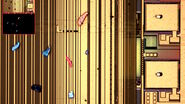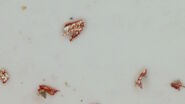Introduction
Products and applications in the industries of metal alloy, automotive, aerospace, transportation, and electronics, as well as the fields of metallography, earth science, and materials science, require materials analysis [1]. Maintaining a cost-effective way to ensure product quality or reliable research results for innovation has becomes a serious concern in the face of increasing competition and ever-stricter international, regional, and organizational standards.
Much time and money is spent using multiple techniques to visually inspect a material and then identify its local composition [1]. The normal workflow starts with sample inspection using an optical microscope with different magnifications and contrasting techniques. The sample composition is then determined with qualitative chemical/elemental spectroscopic analysis. For specific applications, often it is crucial to have reliable data for a material’s local morphology and composition to determine a further course of action. This fact is especially true when serious time and budget limitations force the need to have a way to make quickly the right decision with confidence.
For some cases of inspection, quality control (QC), and failure analysis (FA), identifying contamination and understanding its effects on the base material are necessary. Examples are found in the electronics (soldering and electrical leads on printed circuit boards [PCBs], automotive/transport, and construction (metal panels) industries [2-4].
Efficient analysis of the contamination and underlying base material using a 2-methods-in-1 solution, i.e., the DM6 M LIBS materials analysis system from Leica Microsystems, is described below.
Analysis of contamination and base material
The LIBS method exploits laser ablation to microdrill into and below the contamination layer to reach the base material underlayer. The ability to microdrill allows surface cleaning, i.e. removal of the contamination, and exposure of the base material. The effects of the contamination on the base material can also be investigated. Figure 1 shows an example of microdrilling holes into a copper alloy.
Application for electronics
Inspection of the effect of surface contamination
A USB drive connector (copper [Cu] alloy with silver [Ag] plated surface) was inspected using the DM6 M LIBS 2-in-1 solution. The part shows the presence of contamination (gray circle, Fig. 2A). There are rigorous quality standards defined for the finished surface of electronic components. Surface contamination resulting from the production process or local environment can lead to decreased product quality and even cause malfunctions.
The goal of the inspection is to find out if the contamination is only present on the surface (Fig. 2B) or if reactions have damaged the underlying Ag layer (Fig. 2C).
Content
For inspection of components or parts, such as soldering and leads on printed circuit boards (electronics) or metal panels on vehicles (automotive and transport), understanding the effects of contamination are important. Significant cost and time savings for material analysis can be achieved when exploiting a 2-in-1 solution.
The ability to make confident decisions quickly during production, inspection, quality control, failure analysis, or research and development depends greatly on the rapid availability of relevant, accurate, and reliable materials data.
After inspection by eye, contaminated areas are found on the connector device seen in Figure 2A. To see further details, the region of interest (marked with a gray circle) is inspected at 5x objective magnification with a DM6 M microscope from Leica Microsystems.
Different contrasting methods have been applied to determine the contamination shape and color. With brightfield observation, single dots and other unusual areas were identified (Fig. 3A). By observation in darkfield mode, different colors become visible too (Fig. 3B).
Thus, by visual inspection, the contamination surface can be examined, but the conditions at the interface of the contamination and Ag layer are not revealed.
Using LIBS, the contamination can be analyzed and then removed by laser ablation. Applying multiple shots to the same position also allows chemical signals for the underlying material to be obtained. Depending on the material, 2-5 µm will be ablated by each shot over an area approximately 15 µm in diameter.
By applying LIBS to the uncontaminated surface (white X, Fig. 2A,) a reference signal with distinct emission peaks appearing in the spectrum (Fig. 4A) is obtained. Standard spectra can be compared to the reference signal to identify elements that may be present, such as Cu and Ag (Fig. 4B).
Analysis of contamination
Up to 3 laser shots for LIBS measurements were applied to the same point within the contaminated area. The number of shots needed to microdrill through a layer strongly depends on the layer thickness and material hardness.
In the first spectrum, two prominent signals at 430 nm and 590 nm are seen. By comparing these signals with elemental reference spectra [5], calcium (Ca) and sodium (Na) can be identified (Fig. 5).
Because only the signals of Ca and Na are seen in the first spectrum (Fig. 6A), the underlying material of Ag and Cu was not yet reached by laser ablation. A comparison of the recorded spectrum for 1 laser shot (Fig. 6A) and 2 shots (Fig. 6B) shows that, after the 2nd shot, Cu and Ag peaks appear in the spectrum. With further analysis, the intensity of the Cu and Ag signals continuously increases.
This result indicates the laser microdrilled through the contamination to expose the base material. The spectrum shows that there is a Ag layer underneath the contamination. Thus, the contamination has not damaged the underlying Ag layer. For this case, it took 2 laser shots to penetrate the contamination layer and expose the base material, so the contamination was relatively thin.
Summary
In this report, the use of the DM6 M LIBS materials analysis system, a 2-methods-in-1 solution from Leica Microsystems, for an efficient workflow when analyzing contamination and the underlying base material of a USB connector has been described.
Materials analysis is important for many types of product development (R&D), inspection qualification (IQ), quality control (QC), failure analysis (FA), and technical applications. It is used routinely in multiple industries and fields. Often the time and expense allocated for doing such analysis is limited. However, obtaining reliable results and achieving the desired product quality always remains a priority.
For inspection, QC, or FA of components, identifying contamination and understanding its effects on the base material can be necessary. Soldering and electrical leads on PCBs are examples.
The microscope and LIBS data presented here showed that the contamination layer was relatively thin and did not cause any noticeable irreversible effects, e.g., oxidation or corrosion, on the base material of the USB connector.











